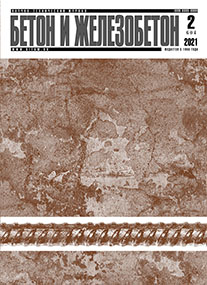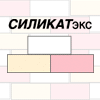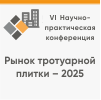№2

April, 2021
Table of contents
Recommendations for the design of compositions of heavy and fine-grained concrete, both conventional and high-strength, are considered. For the first time, approaches
to the selection of self-compacting concrete, as well as straining high-strength heavy and high-strength fine-grained concrete are considered. Historical
information is given on the “Guide to the selection of heavy concrete compositions” (1979) and “ Recommendations for the selection of heavy and fine-grained
concrete (to GOST 27006–86)” (1990). Directly in the 1st edition of the Recommendations, the approaches to the development of concrete compositions to
ensure a given workability have been changed. The methodology for the development of production standards is also presented, i.e. the least labor-intensive
methods for the development of concrete compositions, both normal hardening for monolithic structures and concrete for precast concrete products, are given
in the examples and in the text.
Keywords: concrete, composition selection, recommendations, watertightness, frost resistance.
For citation: Brusser M.I., Podmazova S.A. Design of heavy and fine-grained concrete compositions. Ways of development. Beton i Zhelezobeton [Concrete and Reinforced Concrete]. 2021. No. 2 (604), pp. 3–7. (In Russian).
Keywords: concrete, composition selection, recommendations, watertightness, frost resistance.
For citation: Brusser M.I., Podmazova S.A. Design of heavy and fine-grained concrete compositions. Ways of development. Beton i Zhelezobeton [Concrete and Reinforced Concrete]. 2021. No. 2 (604), pp. 3–7. (In Russian).
The introduction of dispersed mineral additives has a beneficial effect on many properties of concrete. This is due to a physical effect, which manifests itself in
the fact that small particles usually have a finer granulometric composition than Portland cement and manifest themselves as a “micro-filler”. On the other hand,
this may be due to their pozzolanic activity, which is manifested in the ability of silica and alumina to interact with calcium oxide hydrate and form calcium hydrosilicates
and hydroaluminates. In this work, the activity of mineral dispersed components was estimated by the theoretical value of the coefficient of hydration
activity, which was determined by their chemical composition. The actual coefficient of hydration activity was calculated from the maximum value of the mass
gain of dispersed industrial by-products by absorbing Ca(OH)2 from a saturated lime solution by these additives. The quantitative and material composition of
crystalline compounds in industrial by-products was determined by one of the indirect methods, namely, by X-ray phase analysis. Experimental data showed
that the actual pozzolanic activity was much lower than the theoretical value, and therefore the industrial by-products were arranged in the following sequence:
ash-slag mixture coal-enrichment by-product blast furnace granulated slag, which is confirmed by the results of X-ray phase analysis and is consistent with
the values of the compressive strength of concrete tested in different hardening periods.
Keywords: X-ray phase analysis, ash slag, granulated ground blast furnace slag, coal enrichment waste, pozzolan activity, compressive strength of concrete.
For citation: Gaishun E.S., Yavruyan Kh.S., Khalyshev A.K., Bobin V.N. Influence of Dispersed Industrial By-Products on the Strength of Concrete. Beton i Zhelezobeton [Concrete and Reinforced Concrete]. 2021. No. 2 (604), pp. 8–13. (In Russian).
Keywords: X-ray phase analysis, ash slag, granulated ground blast furnace slag, coal enrichment waste, pozzolan activity, compressive strength of concrete.
For citation: Gaishun E.S., Yavruyan Kh.S., Khalyshev A.K., Bobin V.N. Influence of Dispersed Industrial By-Products on the Strength of Concrete. Beton i Zhelezobeton [Concrete and Reinforced Concrete]. 2021. No. 2 (604), pp. 8–13. (In Russian).
An actual task of economic development at the present stage is the creation of an industry for the processing and disposal of industrial waste. . The construction
industry disposes of large-capacity waste from metallurgical industries, which includes blast furnace slag, in significant quantities. Particular attention is paid
to reducing the consumption of clinker cement in concrete, reducing the cost of concrete. The article presents the characteristics of ground granulated slags of
PJSC “Severstal” and concretes with the replacement of up to 50% of cement with ground slag. The economic efficiency of the use of granulated blast furnace
slag consists in expanding the raw material base for obtaining effective building materials; reducing the consumption of clinker (up to 50%); reducing the cost
of binder; ensuring high performance characteristics of concrete when using ground blast furnace granulated slag. Ecological efficiency consists in solving the
environmental problem due to recycling waste from the metallurgical industry.
Keywords: blast furnace granulated slag, fineness of grinding, hydraulic activity, concrete mix, strength, water tightness, durability.
For citation: Titova L.A., Titov M.Yu., Beylina M.I, Shabalin V.A., Mityukova E.V. Efficiency of application of granulated blast furnace slags in the production of concrete mixes and concretes. Beton i Zhelezobeton [Concrete and Reinforced Concrete]. 2021. No. 2 (604), pp. 16–20. (In Russian).
Keywords: blast furnace granulated slag, fineness of grinding, hydraulic activity, concrete mix, strength, water tightness, durability.
For citation: Titova L.A., Titov M.Yu., Beylina M.I, Shabalin V.A., Mityukova E.V. Efficiency of application of granulated blast furnace slags in the production of concrete mixes and concretes. Beton i Zhelezobeton [Concrete and Reinforced Concrete]. 2021. No. 2 (604), pp. 16–20. (In Russian).
The difficulty that accompanies the application of the creep theory in construction practice, according to the authors, is the decomposition of the deformation properties
of concrete. It has developed historically. In 1660, R. Hooke formulated a law that defines the relationship between stress and deformation of an elastic body.
For the first time, A. Consider drew attention to the inelastic properties of concrete (publication in 1905), that is, 245 years later. Since that time, it is possible to count
the study of creep, which was conducted in parallel with the study of the elasticity of concrete and, in connection with the priority of the time of research on elasticity,
creep has become an applied role. Both directions had their own empirical dependencies, which were not connected with each other in any way. This led to the fact
that the dependences obtained from experiments that were carried out under different conditions, the division of the experimental values of deformations into elastic
and inelastic ones were carried out in different ways. This paper shows that the generality property of the aging function makes it possible to avoid this decomposition.
Keywords: concrete, creep, concrete relaxation, measure of creep.
For citation: Nazarenko V.G., Zvezdov A.I., Larionov E.A., Kvasnikov A.A. On some approaches to solving relaxation problems of concrete. Beton i Zhelezobeton [Concrete and Reinforced Concrete]. 2021. No. 2 (604), pp. 21–23. (In Russian).
Keywords: concrete, creep, concrete relaxation, measure of creep.
For citation: Nazarenko V.G., Zvezdov A.I., Larionov E.A., Kvasnikov A.A. On some approaches to solving relaxation problems of concrete. Beton i Zhelezobeton [Concrete and Reinforced Concrete]. 2021. No. 2 (604), pp. 21–23. (In Russian).
Creep and shrinkage of concrete are time-dependent deformations that influence primarily the serviceability, and in some cases also the safety, of reinforced
concrete structures with and without prestressing. Shrinkage is mainly driven by both self-desiccation and moisture drying if exposed to lower relative humidity
environments. In addition, and in combination to that, the large and widely unrecoverable creep deformations of concrete can cause significant modifications
of action effects in structures in terms of internal stress distributions, excessive deflections and loss of prestressing forces, and produce large cracks. All these
effects affect the serviceability and the durability of structures and may impact on their structural safety as well.Many models were formulated to explain and simulate
the time-dependent behavior of concrete, among others. Also, several methods have been presented in the literature to simplify the calculation of creep strain
for structural calculations, such as the effective modulus method, rate of creep method, the ageing coefficient method (AAEM method), and the approach based
on the aging linear viscoelastic theory. More refined and advanced approaches for detailed numerical analyses of the structural effects of creep and shrinkage of
concrete in complex, heterogeneous and sequentially built structures have also been developed in recent times. However, time-dependent behavior of concrete
must be contextualized in a wider comprehensive framework since it is a result of interplay between multiple chemical, physical, and mechanical processes that
are functions of the material composition and its curing as well as the surrounding environmental and loading conditions.
The nature and scales at which all these aforementioned processes take place represent a challenge for the numerical modeling. Concrete is a heterogeneous
material made of two components having very large differences: a cementitious matrix and aggregates. The aggregates are typically much stiff, less porous
and their time-dependent deformations are orders of magnitude lower than those of the cementitious matrix. Staying at the mesoscale, these two phases represent
the main heterogeneity of concrete since at this scale the contribution of the matrix/aggregate interface, called the Interfacial Transitional Zone (ITZ), can
be lumped together with the matrix and distinguish them from the aggregate to represent the main heterogeneity of concrete. By differentiating aggregate from
the matrix, mesoscale interaction at that level can be directly captured; for example, when concrete is loaded in compression, the meso-structure experiences a
well-known splitting mechanism of the aggregates. Mesoscale models are capable of resolving the stresses and strains at such level and can differentiate between
tensile and compressive deformations, while macroscopic models have to average it. This distinction becomes very important during damage and creep/
shrinkage interaction or when internal self-equilibrated stresses are the only source of loading like in non-uniform drying or free expansion under ASR progression
in which cases the macroscopic stresses are equal to zero. Hence, macroscopic continuous models have to explicitly account for these lower-scale phenomena
in their constitutive laws.
 |
 |
 |
 |
 |




